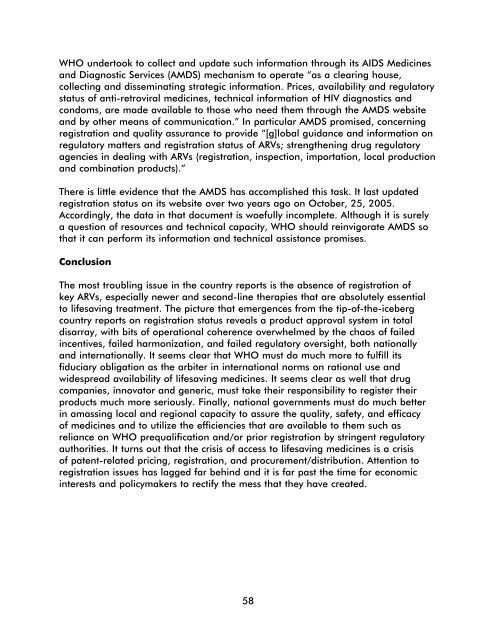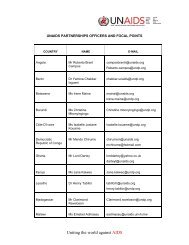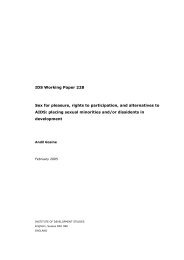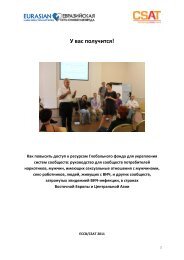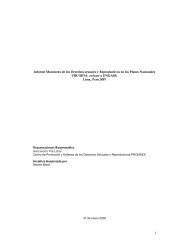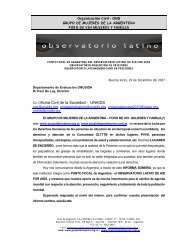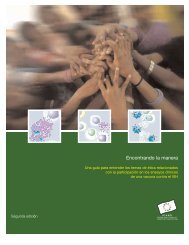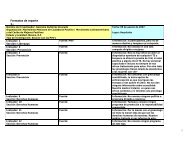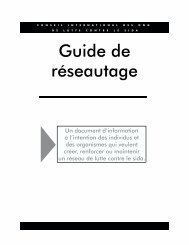Lack of post-approval quality assurance and regulation of medicinesSome countries report that <strong>the</strong> drug regulatory system in <strong>the</strong>ir country is simply toolax, resulting in a lack of government accountability. In o<strong>the</strong>r contexts, <strong>the</strong> problemis not all-pervasive, but is instead limited to weaknesses in post-approval qualityassurance (Belize). Although <strong>the</strong>re are some examples of regional cooperation inquality assurance (Belize) or of procurement agents providing such services on acontract basis (Nigeria/Axios) and as part of a bilateral initiative (US SCMS), ingeneral quality assurance programs seem weak. Given <strong>the</strong> critical importanceof ensuring that people receive good quality medicines, major efforts should beundertaken at <strong>the</strong> multilateral, regional, and national level to prevent formaland informal marketing of counterfeits and substandard, expired, or degradedmedicines. Developing countries should commit substantially more of <strong>the</strong>ir existingregulatory capacity to quality assurance, and people living with HIV/<strong>AIDS</strong> shouldreceive more treatment literacy on <strong>the</strong> danger of obtaining medicines fromunofficial sources.It is important to note that <strong>the</strong> US and its key trading partners– including Canada,<strong>the</strong> European Union (with its 27 Member States), Japan, Korea, Mexico, NewZealand, and Switzerland– have started negotiations on an Anti-CounterfeitingTrade Agreement 6 . Although counterfeiting and substandard medicines are certainlyan important issue for developing countries, <strong>the</strong>re are reasons to suspect that <strong>the</strong>motivation for this new focus on counterfeits is at least partially to attack <strong>the</strong> qualityof generic production and to seek even stronger IPR-enforcement, border-control,product-tracing, and anti-diversion measures in future trade agreements.Lack of a global, up-to-date, accessible registry on registration status ofHIV/<strong>AIDS</strong> medicinesAs is true with patents, <strong>the</strong>re is an appalling lack of transparency on a globalscale concerning <strong>the</strong> registration status of ARVs and OI medicines. With rareexceptions, innovator drug companies don’t list up-to-date registration status onpublicly accessible websites–-nor for that matter do generic producers. Likewise,governments are often non-transparent, although Uganda is an exception, sinceit publishes a national drug-registration list on a monthly basis. It is unsurprisingthat ITPC researchers had such a hard time accessing ARV registration data in <strong>the</strong>irhome countries and that, even at this date, civil society does not have access toverified information.6 Office of <strong>the</strong> US Trade Representative. “Ambassador Schwab Announces U.S. Will Seek NewTrade Agreement to Fight Fakes.” October 23, 2007. http://www.ustr.gov/Document_Library/Press_Releases/2007/October/Ambassador_Schwab_Announces_US_Will_Seek_New_Trade_Agreement_to_Fight_Fakes.html?ht=57
WHO undertook to collect and update such information through its <strong>AIDS</strong> Medicinesand Diagnostic Services (AMDS) mechanism to operate “as a clearing house,collecting and disseminating strategic information. Prices, availability and regulatorystatus of anti-retroviral medicines, technical information of HIV diagnostics andcondoms, are made available to those who need <strong>the</strong>m through <strong>the</strong> AMDS websiteand by o<strong>the</strong>r means of communication.” In particular AMDS promised, concerningregistration and quality assurance to provide “[g]lobal guidance and information onregulatory matters and registration status of ARVs; streng<strong>the</strong>ning drug regulatoryagencies in dealing with ARVs (registration, inspection, importation, local productionand combination products).”There is little evidence that <strong>the</strong> AMDS has accomplished this task. It last updatedregistration status on its website over two years ago on October, 25, 2005.Accordingly, <strong>the</strong> data in that document is woefully incomplete. Although it is surelya question of resources and technical capacity, WHO should reinvigorate AMDS sothat it can perform its information and technical assistance promises.ConclusionThe most troubling issue in <strong>the</strong> country reports is <strong>the</strong> absence of registration ofkey ARVs, especially newer and second-line <strong>the</strong>rapies that are absolutely essentialto lifesaving treatment. The picture that emergences from <strong>the</strong> tip-of-<strong>the</strong>-icebergcountry reports on registration status reveals a product approval system in totaldisarray, with bits of operational coherence overwhelmed by <strong>the</strong> chaos of failedincentives, failed harmonization, and failed regulatory oversight, both nationallyand internationally. It seems clear that WHO must do much more to fulfill itsfiduciary obligation as <strong>the</strong> arbiter in international norms on rational use andwidespread availability of lifesaving medicines. It seems clear as well that drugcompanies, innovator and generic, must take <strong>the</strong>ir responsibility to register <strong>the</strong>irproducts much more seriously. Finally, national governments must do much betterin amassing local and regional capacity to assure <strong>the</strong> quality, safety, and efficacyof medicines and to utilize <strong>the</strong> efficiencies that are available to <strong>the</strong>m such asreliance on WHO prequalification and/or prior registration by stringent regulatoryauthorities. It turns out that <strong>the</strong> crisis of access to lifesaving medicines is a crisisof patent-related pricing, registration, and procurement/distribution. Attention toregistration issues has lagged far behind and it is far past <strong>the</strong> time for economicinterests and policymakers to rectify <strong>the</strong> mess that <strong>the</strong>y have created.58
- Page 1 and 2:
Missing the Target #5:Improving AID
- Page 4 and 5:
ArgentinaDr. María Lorena Di Giano
- Page 8 and 9:
Executive SummaryAt the G8 meeting
- Page 12:
• UN agencies should provide incr
- Page 16 and 17: Price should not be a barrier when
- Page 18 and 19: The Global Fund and UNITAID: The Fu
- Page 20 and 21: The real cost of free treatmentBy a
- Page 22 and 23: Remaining work for asuccessful prog
- Page 24 and 25: DOMINICAN REPUBLICto access rapid t
- Page 26 and 27: DOMINICAN REPUBLICIn Santo Domingo
- Page 28 and 29: ZIMBABWEtreatment, representing 35
- Page 30 and 31: ZIMBABWEAccording to the Medicines
- Page 32 and 33: ZIMBABWEZimbabwe’s application fo
- Page 34 and 35: ZIMBABWENational government• Addr
- Page 36 and 37: RUSSIAMigrantsRussia, with the seco
- Page 38 and 39: a person with HIV will die very qui
- Page 40 and 41: FamiliesIn Kenya, families are the
- Page 42 and 43: INDIA2. Provide pediatric formulati
- Page 44 and 45: Linking nutrition and treatmentBy W
- Page 46 and 47: Most people living with advanced HI
- Page 48 and 49: only available in the capital, Yaou
- Page 50 and 51: ZAMBIAFindings in particular provin
- Page 52 and 53: The DACA for Chadiza District was a
- Page 54 and 55: Many health care workers are inadeq
- Page 56 and 57: DRUG REGISTRATION BARRIERS & LOGJAM
- Page 58 and 59: Country ATV RLPV/rLPV/r(HS)TDFArgen
- Page 60 and 61: development and registration. Likew
- Page 62 and 63: Capacity issues and delays in the W
- Page 66 and 67: ARV PROCUREMENT, REGISTRATION,AND S
- Page 68 and 69: ARGENTINAParallel importingRelating
- Page 70 and 71: ARGENTINAAccess to ARVsNo difficult
- Page 72 and 73: Viral load tests are available, but
- Page 74 and 75: Cambodiaby Mony PenOnly pharmacists
- Page 76 and 77: ChinaBy anonymous Missing the Targe
- Page 78 and 79: CHINAThe current process for regist
- Page 80 and 81: Dominican RepublicBy Eugene Schiff
- Page 82 and 83: IndiaBy Abraham KK, Celina D’Cost
- Page 84 and 85: MalawiBy Lot Nyirenda and Grace Bon
- Page 86 and 87: MALAWIStock-outsAccording to an ext
- Page 88 and 89: MoroccoBy Othman MelloukMorocco has
- Page 90 and 91: Determine the patent status of all
- Page 92 and 93: MOROCCOThe shortage occurred becaus
- Page 94 and 95: As of November 2007, the unit cost
- Page 96 and 97: NIGERIADiagnostic testsDiagnostic t
- Page 98 and 99: The government’s initial inabilit
- Page 100 and 101: Increase training and capacity buil
- Page 102 and 103: treatment practice. The Minster ann
- Page 104 and 105: Ugandaby Richard Hasunira, Prima Ka
- Page 106 and 107: UGANDAExtracts from the MoH’s rep
- Page 108 and 109: ZAMBIAIn gathering this information
- Page 110 and 111: However, since manufacturing prices
- Page 112 and 113: 105SHORT SUMMARY
- Page 114:
PAKISTANAccess for marginalized gro


